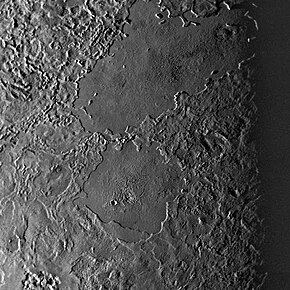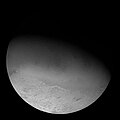Tuonela Planitia
 Voyager 2 image of Tuonela Planitia across the upper half, with Ruach Planitia below. Several "islands" occupy Tuonela Planitia's interior, with Kasu Patera at the upper right | |
| Feature type | Walled plain, cryolava lake |
|---|---|
| Location | Monad Regio, Triton |
| Coordinates | 34°00′N 14°30′E / 34.000°N 14.500°E[1] |
| Depth | ~200 m[2] |
| Dimensions | ~400 x 150 km[2] |
| Discoverer | Voyager 2 |
| Eponym | Tuonela |
Tuonela Planitia is an elongated plain and probable cryolava lake on Neptune's moon Triton. Located in Triton's northern hemisphere within Monad Regio, it overlies part of Triton's unusual cantaloupe terrain. As with neighboring Ruach Planitia and the other walled plains on Triton, Tuonela Planitia is among the youngest features on Triton's surface.
Discovery and naming
[edit]Tuonela Planitia was discovered alongside Triton's other surface features by the Voyager 2 spacecraft during its flyby of the Neptune system on 25 August 1989.[3] The name Tuonela Planitia was approved by the International Astronomical Union (IAU) in 1991; the name originates from the underworld realm of the dead from Finnish mythology.[1]
Geology
[edit]Of the four observed major walled plains on the surface of Triton, Tuonela Planitia is by far the largest. In contrast to neighboring Ruach Planitia, which is roughly circular in shape, Tuonela Planitia is significantly elongated. Its longest axis of roughly 400 km is nearly thrice longer than its short axis of roughly 150 km, and its longest axis is aligned roughly north to south.[2] Tuonela Planitia's alignment may be tectonically controlled, although north–south trending tectonic features are usually found closer to Triton's equator.[4]: 905 Its floor is broadly flat, though its surface may be slightly warped; the low quality of Voyaer 2 elevation data in the region makes it uncertain as to whether or not the warping is a real topographical feature or an artifact.[5] The depressed floor of Tuonela Planitia is bound by a single scarp with a crenulated profile; the scarp appears to superficially resemble coastlines on Earth, with alcoves, bay-like features, and numerous "islands" rising 100–250 meters above the floor of Tuonela Planitia.[2][4]: 886, 888 As with Ruach Planitia and the two other major walled plains of Triton, Tuonela Planitia hosts an unusual cluster of pits within its flat plains,[4]: 893 though the pits of Tuonela Planitia are located within its northern "lobe". The largest pit in Tuonela Planitia has a low dome centered within it, rising some 200 meters above its surrounding moat. Tuonela Planitia cuts into the older cantaloupe terrain, indicating that it (along with other walled plains) is one of the youngest features on Triton's surface.[5][4]: 939
Like Ruach Planitia, it has been hypothesized that Tuonela Planitia represents a massive basin infilled with cryolava, water-dominated erupted material analogous to silicate-dominated lava. The pit clusters within the walled plains like Tuonela Planitia have been compared to volcanic vents or drainage pits, and they may represent sites whence material erupted from.[6]: 870 [7]: 162, 219 As with terrestrial calderas on Earth, the eruptive history of Tuonela Planitia may have occurred in multiple stages, with an early stage of explosive eruptions involving high-viscosity or high-volatility material that clears a caldera, later transitioning into a stage of effusive eruption that fills the basin with cryolava.[4]: 921, 940 The shoreline-like profile of Tuonela Planitia's walls indicate that they may have been eroded by fluid sitting within the basins for extended periods of time, and the surrounding smooth terrain may represent sites of viscous cryolava flows or cryoclastic deposits.[4]: 921 However, Tuonela Planitia's walls do not appear to resemble the collapse scarps of typical calderas.[6]: 870
Both Tuonela Planitia and Ruach Planitia appear to have bounding scarps that were subsequently modified by erosive processes, carving channels and valleys into their faces. In particular, Tuonela Planitia's eastern wall is host to a system of short, dense, narrow channels that may have been carved by glacial activity.[2] Other features of probable cryovolcanic origin also lie close to Tuonela Planitia, such as a number of pitted cones south of the plain. These pitted cones are roughly conical hills with central depressions, superficially resembling terrestrial and lunar cinder cones.[4]: 922
See also
[edit]- Ruach Planitia – Walled plain on Triton
References
[edit]- ^ a b "Tuonela Planitia". Gazetteer of Planetary Nomenclature. USGS Astrogeology Research Program. (Center Latitude: 34.00°, Center Longitude: 14.50°; Planetographic, +East)
- ^ a b c d e Sulcanese, Davide; Cioria, Camilla; Kokin, Osip; Mitri, Giuseppe; Pondrelli, Monica; Chiarolanza, Giancula (March 2023). "Geological analysis of Monad Regio, Triton: Possible evidence of endogenic and exogenic processes". Icarus. 392. Bibcode:2023Icar..39215368S. doi:10.1016/j.icarus.2022.115368. S2CID 254173536. Retrieved 12 March 2024.
- ^ Bolles, Dana (March 2024). "Voyager 2". NASA. Archived from the original on 3 May 2024. Retrieved 5 May 2024.
- ^ a b c d e f g Croft, S. K.; Kargel, J. S.; Kirk, R. L.; et al. (1995). "The geology of Triton". Neptune and Triton: 879–947. Bibcode:1995netr.conf..879C.
- ^ a b Schenk, Paul; Beddingfield, Chloe; Bertrand, Tanguy; et al. (September 2021). "Triton: Topography and Geology of a Probable Ocean World with Comparison to Pluto and Charon". Remote Sensing. 13 (17): 3476. Bibcode:2021RemS...13.3476S. doi:10.3390/rs13173476.
- ^ a b McKinnon, William B.; Kirk, Randloph L. (2014). Encyclopedia of the Solar System (Third ed.). doi:10.1016/C2010-0-67309-3. ISBN 978-0-12-415845-0. Archived from the original on 16 December 2021. Retrieved 15 April 2024.
- ^ Gregg, Tracy K. P.; Lopes, Rosaly M. C.; Fagents, Sarah A. (December 2021). Planetary Volcanism across the Solar System. doi:10.1016/B978-0-12-813987-5.00005-5. ISBN 978-0-12-813987-5. S2CID 245084572. Archived from the original on 11 March 2024. Retrieved 12 March 2024.

